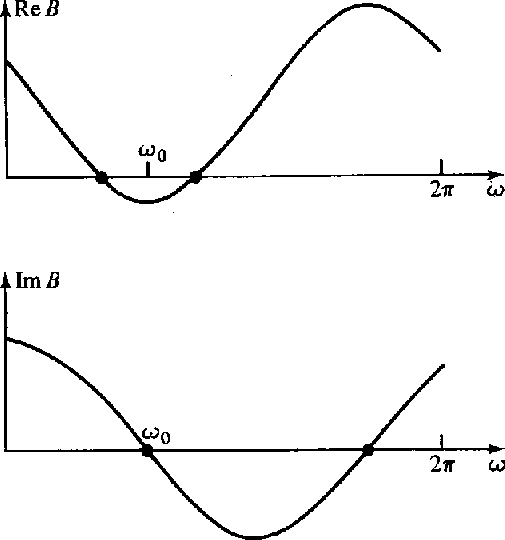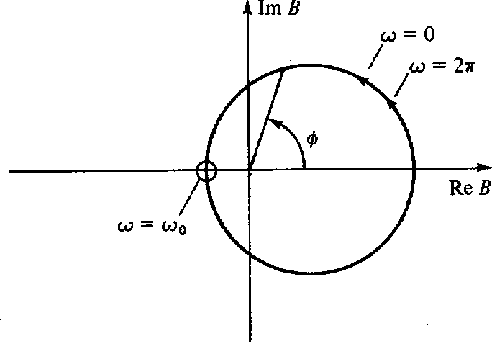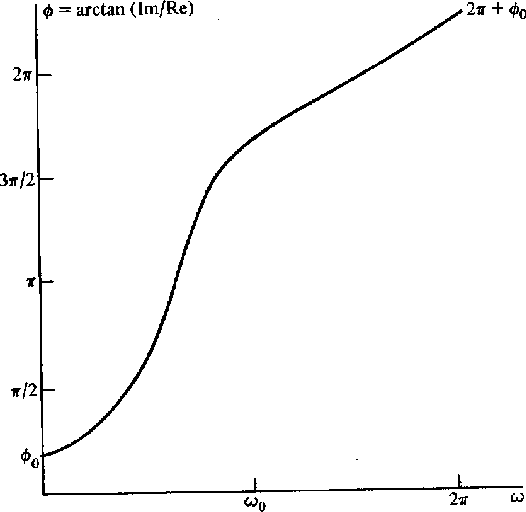
Let us consider the phase shift of the two-term filter
 |
||
By definition, phase is the arctangent of the ratio of the imaginary part to the real part.
A graph of phase as a function of frequency
looks radically different for ![]() than for
than for ![]() .
See Figure 4 for the case
.
See Figure 4 for the case ![]() .
.
|
2-4
Figure 4 Real and imaginary parts of the Z transform |  |
The phase is the arctangent of ![]() .
The easiest way to keep track of the phase is in the complex B plane.
This is shown in Figure 5.
.
The easiest way to keep track of the phase is in the complex B plane.
This is shown in Figure 5.
|
2-5
Figure 5 Phase of the two-term filter of Figure 4. |  |
Thus phase as a function of frequency is shown in Figure 6.
Notice that the phase ![]() at
at ![]() is the same as the phase at
is the same as the phase at ![]() .
This follows because the real and imaginary parts
are periodic with
.
This follows because the real and imaginary parts
are periodic with ![]() . The situation will be different
when there is a zero inside the unit circle; that is,
. The situation will be different
when there is a zero inside the unit circle; that is, ![]() .
The real and imaginary parts are shown in Figure 7 and
the complex plane in Figure 8.
.
The real and imaginary parts are shown in Figure 7 and
the complex plane in Figure 8.
|
2-6
Figure 6 The phase of a two-term minimum-phase filter. |  |
|
2-7
Figure 7 Real and imaginary parts of the two-term nonminimum-phase filter, |  |
|
2-8
Figure 8 Phase in complex plane. |  |
The phase ![]() increases by
increases by ![]() as
as ![]() goes from zero to
goes from zero to ![]() because the circular path surrounds the origin. The phase curve is shown
in Figure 9. The case
because the circular path surrounds the origin. The phase curve is shown
in Figure 9. The case
![]() where
where ![]() has come to be called minimum phase or minimum delay.
has come to be called minimum phase or minimum delay.
|
2-9
Figure 9 The phase of a two-term nonminimum-phase filter. |  |
Now we are ready to consider a complicated filter like
| |
(12) |
By the rules of complex-number multiplication the phase of
B(Z) is the sum of the phases in the numerator minus the sum of the
phases in the denominator. Since we are discussing realizable filters
the denominator factors must all be minimum phase, and so the denominator
phase curve is a sum of curves like Figure 6.
The numerator factors may or may not be minimum phase.
Thus the numerator phase curve is a sum of curves like
either Figure 6 or Figure 9.
If any factors at all are like Figure 9,
then the total phase will resemble Figure 9
in that the phase at ![]() will be greater than
the phase at
will be greater than
the phase at ![]() . Then the filter will be nonminimum phase.
. Then the filter will be nonminimum phase.